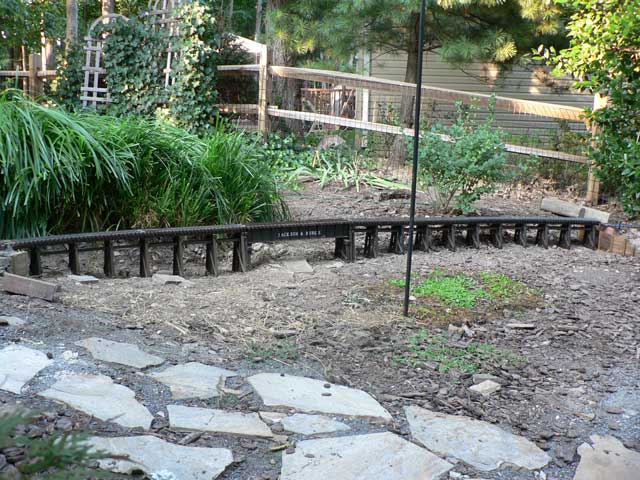My 103F day working on track I agree that free floating track has problems. I am gradually changing all my road bed to either anchored-supported, ladder [on next expansion], or concreted ballast. I also converted to battery power after one season of fighting track maintenance. Now I run year round. Newest Project: Along the front of my layout, I have a 4.5% grade I wanted to reduce. In my infinite wisdom, I chose a 103f day to make the change. Before.

Notice the track bed was raised to even with the train platform. Plastic wood was the chosen product since I had some left over from building my deck. This is an all plastic recycled product that is also used for the boardwalks in Yellowstone Park.

A plank of the material was also placed under the switch control and first two feet of the siding [picture not available:(]. Boards were cut to follow the contour of the track.

The bridge was raised to the same elevation and the downhill grade was reduced as I ballasted the track back up the hill. The WD-40 was used in an emergency to exterminate a nest of ants I unfortunately dug up.

The highway also had to be raised at the rail crossing.

The Highway crossing was raised, and ballast was added. I finally finished the pavement across the rails after two years.

Now the grade is about 2%. There is one more phase to this project. There will be a concrete retaining wall along the edge of the highway [going towards the top of the above picture]. Retaining forms were put at the edge of the highway next to the raised rail. Ballast was filled to the top of the forms. Mortor was dry spread over the gravel, and watered into the ballast. This process will take several days and three applications before the forms are removed. Pictures of the retaining wall will be posted when completed. Looking in retrospect, this project might have been easier if I had built a ladder rather than using solid stock. JimC.

 It has already paid off - I had a curve in front of the flower bed and when I was measuring grades I found it would have to be too high above the flowers. I undid all the screws on one side and recurved it behind the bed. Just that easy. It also allows for consistant grades as it doesn’t seem to sag very much. More than PT, of course - but then it also makes it easier to create smooth grades with gentle vertical curves.
It has already paid off - I had a curve in front of the flower bed and when I was measuring grades I found it would have to be too high above the flowers. I undid all the screws on one side and recurved it behind the bed. Just that easy. It also allows for consistant grades as it doesn’t seem to sag very much. More than PT, of course - but then it also makes it easier to create smooth grades with gentle vertical curves. The ladder method certainly solves that problem, especially in easement and compound curves. For straight runs (which I have many) PT is a lot simpler. Perhaps the best solution is a combination of methods depending on the location.
The ladder method certainly solves that problem, especially in easement and compound curves. For straight runs (which I have many) PT is a lot simpler. Perhaps the best solution is a combination of methods depending on the location.












